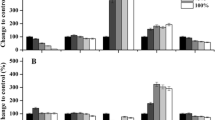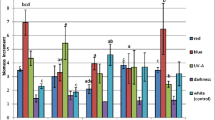Abstract
Resorcinol (1,3-dihydroxybenzene) was identified as one of the major constituents of the exudate ofNuphar lutea seedlings, which were raised from seeds and cultivated under axenic conditions. The compound is released from the plants in considerable amounts (up to 15 nmol/seedling/day). Highest rates of resorcinol exudation were measured when the seedlings were incubated under physiological conditions (macronutrient and light supply) that resembled those of natural stands of the plant. An inverse correlation exists between nitrate and/or light supply and resorcinol production. Because of its generally toxic properties, resorcinol is suggested to play a role as an allelochemical in interactions between macrophytes and other organisms of the aquatic ecosystem. A first approach of resorcinol application to zooplankton and phytoplankton organisms resulted in deleterious effects against aDaphnia species. Two Cryptophyceae species reduced resorcinol concentration to zero, showing a concomitant increase of the size of starch granule enclosures. Cyanophyceae and Chlorophyceae seemed not to be affected.
Similar content being viewed by others
References
Appel, H. M. 1993. Phenolics in ecological interactions—the importance of oxidation.J. Chem. Ecol. 19:1521–1552.
Barrero, A. F., Cabrera, E., Rodriguez, I., andPlanelles, F. 1994. Alkylresorcinols and isocoumarins fromOnonis pubescens, Phytochemistry 35:493–498.
Bouillant, M. L., Jacoud, C., Zanella, Favrebonvin, andBally, R. 1994. Identification of 5-(12-heptadecenyl)-resorcinol in rice root exudates.Phytochemistry 35:769–771.
Chapman, P. J., andRibbons, D. W. 1976. Metabolism of resorcinylic compounds by bacteria: Orcinol pathway inPseudomonas putida.J. Bacteriol. 125:975–984.
Droby, S., Jacoby, B., andGoldman, A. 1987. Induction of antifungal resorcinols in flesh or unripe mango fruits and its relation to latent infection byAlternaria alternata.Physiol. Mol. Plant Pathol. 30:285–292.
Elakovich, S. D., andWooten, J. W. 1991. Allelopathic potential ofNuphar lutea (L.) Sibth. & Sm. (Nymphaeaceae).J. Chem. Ecol. 17:707–714.
Fischer, N. H., Williamson, G. B., Weidenhamer, J. D., andRichardson, D. R. 1994. In search of allelopathy in the Florida scrub: The role of terpenoids.J. Chem. Ecol. 20:1355–1380.
Gopal, B., andGoel, U. 1993. Competition and allelopathy in aquatic plant communities.Bot. Rev. 59:155–210.
Grodzinsky, A. M. 1982. Evolutionary problems of the chemical interaction among plants, pp. 133–143,in V. H. A. Novak and J. Mlikovsky (eds.). Evolution and Environment. Czechoslovak Academy of Sciences, Prague, Czechoslovakia.
Groseclose, E. E., andRibbons, D. W. 1981. Metabolism of resorcinylic compounds by bacteria: New pathway for resorcinol catabolism inAzotobacter vinelandii.J. Bacteriol. 146:460–466.
Gross, E. M., Meyer, H., andSchilling, G. 1996. Release and ecological impact of algicidal hydrolyzable polyphenols inMyriophyllum spicatum.Phytochemistry 41:133–138.
Harborne, J. B. 1988. Introduction to Ecological Biochemistry, 3rd. ed., Academic Press, London.
Harborne, J. B., andSimmonds, N. W. 1964. The natural distribution of phenolic aglycones, pp. 77–128,in J. B. Harborne (ed.). Biochemistry of Phenolic Compounds, Academic Press London.
Hegnauer, R. 1990. Chemotaxonomie der Pflanzen, Vol. 9, Birkhäuser Verlag, Zürich, p. 73.
Hellebust, J. A. 1974. Extracellular products, pp. 838–863,in W. D. P. Steward (ed.). Algal Physiology and Biochemistry, Botanical Monographs, Vol. 10. Blackwell, Oxford.
Ho, S.-C. 1979. Structure, species diversity and primary production of epiphytic algal communities in the Schöhsee (Holstein), West Germany. Dissertation. Christian-Albrechts-Universität, Kiel, Germany.
Kachhi, A. N., andModi, V. V. 1976. Properties of catechol-2,3-oxygenase fromPseudomonas aeruginosa.Indian J. Biochem. Biophys. 13:234–236.
Moebus, K., andJohnson, K. M. 1974. Exudation of dissolved organic carbon by brown algae.Mar. Biol. 26:117–125.
Neujahr, H. Y., andVarga, J. M. 1970. Degradation of phenols by intact cells and cell-free preparations ofTrichosporon cutaneum.Eur. J. Biochem. 13:37–44.
Niva 1986. NIVAs Kultursamling av Alger. Culture Collection of Algae at Norwegian Institute for Water Research. Catalogue of Strains, Edition 1986. Oslo, Norway.
Ostrofsky, M. L., andZettler, E. R. 1986. Chemical defences in aquatic plants.Ecology 74:279–287.
Paller, G., Hommel, R. K., andKleber, H. P. 1995. Phenol degradation byAcinetobacter calcoaceticus NCIB 8250.J. Basic Microbiol. 35:325–335.
Putnam, A. R., andTang, C.-S. 1986. The Science of Allelopathy. John Wiley & Sons, New York.
Ragan, M. A., andJensen, A. 1979. Qualitative studies on brown algal phenols. III. Light-mediated exudation of polyphenols fromAscophyllum nodosum (L.) Le Jol.J. Exp. Mar. Biol. Ecol. 36:91–101.
Rice, E. L. 1984. Allelopathy (Physiological Ecology). Academic Press, Orlando, Florida.
Shailubhai, K., Rao, N. N., andModi, V. V. 1982. Degradation of benzoate and salicylate byAspergillus niger.Indian J. Exp. Bot. 20:166–168.
Shailubhai, K., Somayaji, R., Rao, N. N., andModi, V. V. 1983. Metabolism of resorcinol and salicylate inAspergillus niger.Experientia 39:70–72.
Smits, A. J. M., van Avesaath, P. H., andvan der Velde, G. 1990. Germination requirements and seed banks of some nymphaeid macrophytes:Nymphaea alba L.,Nuphar lutea (L.) Sm. andNymphoides peltata (Gmel.) O. Kuntze.Freshwater Biol. 24:315–326.
Sondergaard, M. 1981. Kinetics of extracellular release of14C-labelled organic carbon by submerged macrophytes.Oikos 36:331–347.
Sütfeld, R. 1989. Preparative liquid chromatography with analytical separation quality. Interval injection/displacement reversed phase high-performance liquid chromatography.J. Chromatogr. 464:103–115.
Sütfeld, R. 1993. Exudation of UV-light absorbing natural products by seedlings ofNuphar lutea.Chemoecology 4:108–114.
Szczepanska, W. 1987. Allelopathy in helophytes.Arch. Hydrobiol. Beih. Ergebn. Limn. 27:173–179.
The Merck Index. 1983. An Encyclopedia of Chemicals, Drugs, and Biologicals, 10th ed. M. Windholz (ed.). Merck & Co., Rahway, New Jersey.
Tschech, A., andSchink, B. 1985. Fermentative degradation of resorcinol and resorcylic acids.Arch. Microbiol. 143:52–59.
Weidenhamer, J. D., Menelaou, M., Macias, F. A., Fischer, N. H., Richardson, D. R., andWilliamson, G. B. 1994. Allelopathic potential of menthofuran monoterpenes fromCalamintha ashei.J. Chem. Ecol. 20:3345–3359.
Wetzel, R. G. 1993. Humic compounds from wetlands: Complexation, inactivation, and reactivation of surface-bound and extracellular enzymes.Verh. Int. Ver. Limn. 25:122–128.
Williamson, G. B., Richardson, D. R., andFischer, N. H. 1992. Allelopathic mechanisms in fire-prone communities, pp. 58–75,in S. J. H. Rizvi and V. Rizvi (eds.). Allelopathy: Basic and Applied Aspects. Chapman and Hall, London.
Willis, R. J. 1994. Terminology and trends in allelopathy.Allelopathy J. 1:6–28.
Wium-Andersen, S. 1987. Allelopathy among aquatic plants.Arch. Hydrobiol. Beih. Ergebn. Limn. 27:167–172.
Author information
Authors and Affiliations
Rights and permissions
About this article
Cite this article
Sütfeld, R., Petereit, F. & Nahrstedt, A. Resorcinol in exudates ofNuphar lutea . J Chem Ecol 22, 2221–2231 (1996). https://doi.org/10.1007/BF02029542
Received:
Accepted:
Issue Date:
DOI: https://doi.org/10.1007/BF02029542




